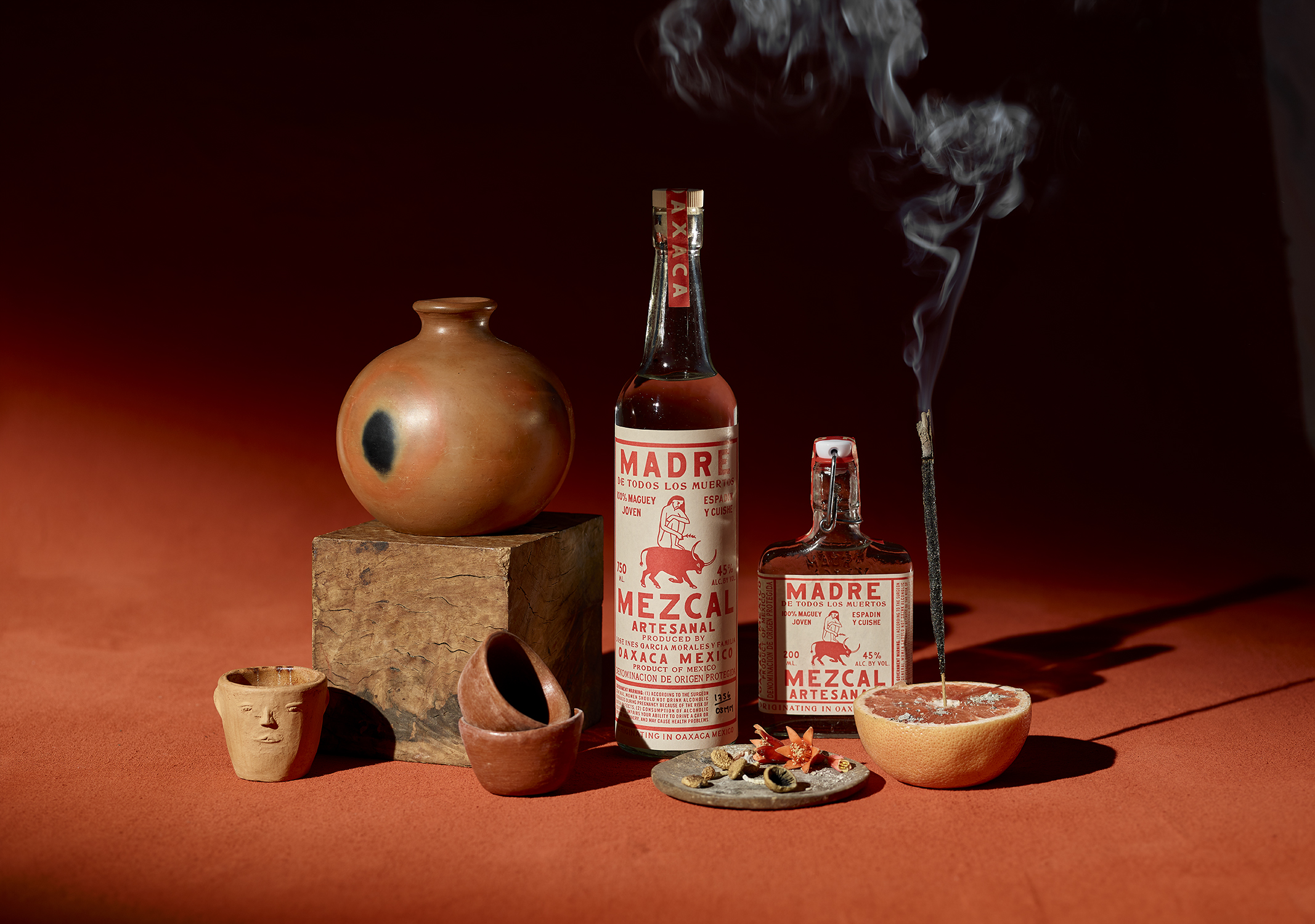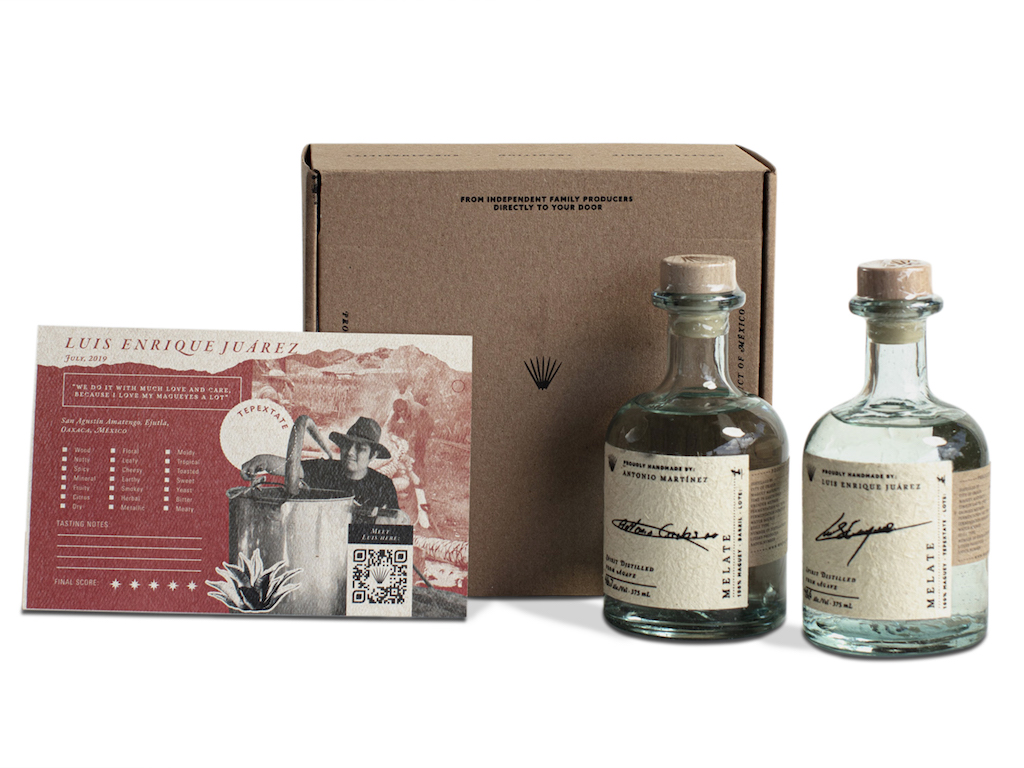The Best Mezcals to Try Right Now
There’s no better time to sample this iconic Mexican spirit.

We recently did a deep dive into mezcal, offering the past, present and complex future of Mexico’s favorite spirit. Now that you’ve got your basics down you’ll need to know what bottles to hunt, so we tapped some of America’s top agave lovers to offer their favorite expressions — from small batch cowhide-fermented spirits to sustainably produced, impeccably-crafted brands you’ll likely find at your local bodega… and everything in between.
Here are the preferred mezcal bottles from our handpicked squad of mezcal experts: Wen Ho of Los Angeles agave temple Neat, Melanie Getman of True Laurel in San Francisco, Amanda Swanson of Fine & Rare in New York City, K & L Wine buyer David Othenin-Girard, and Ilegal Mezcal’s John Rexer. Happy hunting!
Suggestions by Wen Yeh, owner of Neat, Canary, The Belmont and BRÜ HAUS pub:
El Jolgorio “Tobaziche”
https://www.instagram.com/p/BuCrjRaFn3o
I just love the flavor and layers in this limited production Tobaziche expression made by maestro Ignacio Parada. He’s got the Midas touch when it comes to any agave distillate; everything he makes is outstanding. $150
La Herencia de Sanchez “Ponche de Frutas”
A vegan Pechuga distilled with fruits. Maestro Romulo Sanchez of Rey Campero produces his own line called La Herencia de Sanchez; this particular vegan espadín pechuga is arguably one of the best pechugas I’ve ever had. The flavors, subtleness and complexity are just exquisite.
$100
Almamezcalera & Mezcalito “Pal’Alma Puebla Maguey Espadilla”
Everything Erick Rodriguez makes is small production (30-100 liters) and is almost impossible to find outside of Mexico. Absolutely mind-blowing that he’s able to capture these flavors.
$75
Cinco Sentidos “Papalometl ‘Batch PM02’ Santa María Ixcatlan”
https://www.instagram.com/p/B5LfwyTFlGp
Limited production Papalometl agave spirit that’s hand-mashed with wooden mallets, fermented in cowhide and distilled in clay pot stills. Layers of flavors and complexity. Absolutely one of my favorite (agave) spirits I’ve ever tasted.
$110
Mal Bien “Espadín”
Fantastic everyday sipper or mixed into a cocktail. There’s nothing out there that remotely compares to the quality and value this espadín represents. $35
Suggestions by Melanie Getman, lead bartender at San Francisco’s True Laurel:
Del Maguey “Chichicapa”
https://www.instagram.com/p/aSLAQmh6mc
I love this expression in particular because it was one of the first mezcals that made me want to stop and really savor it. It was extremely unique to me at the time. I’d been introduced to mezcal before and this was one of the first that really made me stop and really treat it palate-wise the way I would say, wine. I am a huge fan of the Del Maguey portfolio and have watched their products improve and expand with astounding promptitude and in terms of accessibility I think this mezcal nails it. It’s easy to drink on its own, its long finish makes it a prominent choice for those looking to make a cocktail that embodies “mezcal” (i.e. smoky), and the predominant citrus and herbal notes make it a no brainer for subbing into commonly loved classic cocktails.
$70
Cinco Sentidos “Pechuga de Mole Poblano”
https://www.instagram.com/p/Bx2laQllrIh
The brand as a whole is a direct aftermath of an amazing culinary group in Oaxaca (Destilado) pairing up with amazing mezcaleros to create a wide range of flavor profiles that speak true to both the old and new. They manage to pull the essence out of the maguey that they distill, while still being able to have fun with it…which is not really happening quite yet down in Oaxaca. This pechuga is the craziest of crazy I’ve ever tasted. It’s what I imagine the Chiquita banana girl would taste like if she fell into a still.
$140
Yola
Even though it’s not a Oaxacan owned and operated company, I appreciate that this is an all-female owned and operated business that, overall, puts out a damned good product. These ladies hail from Cali and definitely take the ethos of sustainability and transparency that’s come so wonderfully to the forefront of importance in our state and into their product. They work directly with their mezcaleros to produce a delicious and ethical product while empowering women in a male dominated industry.
$50
Siembre Valles Ancestral
While technically marketed as a tequila due to its production in Jalisco, this is a spirit that’s produced in an ancestral manner to bring out the true nuances of traditional Mexican spirits. While it is made from blue agave, and is from Jalisco, the piñas are treated in the O.G. way that brings out the notes we love and recognize in mezcal. Remember, all tequila is mezcal, but not all mezcal is tequila. I love this product because it’s one that truly blurs the lines.
$120
Madre

This as far as I know one of the most sustainably focused brands out there. Their focus on transparency on how they run every aspect of their business as well as the effort that they’ve put into bringing a well-crafted and underrated spirit to the masses has made me a forever fan. Down to the authenticity and willingness to hold fast to the packaging of what they are pushing shows me how down to earth this production is. Mix that with a true to taste product, I give this mezcal all the accolades I can give. I want to see what happens when this brand realizes the extent of what they can do.
$50
Suggestions by David Othenin-Girard, spirits buyer for K & L Wine Merchants:
Mezonte “Jorge Perez”
https://www.instagram.com/p/BZFEz7bDkuw
Michoacan has been left out mostly of recent explosive growth in Mezcal, but there are some absolute masters. Jorge Perez is one of the best; locally his product is extremely rare and sought-after. It’s distilled from Alto agave, roasted in underground pits over oak, hand-mashed and double distilled on a wooden pot still fashioned from the sacred Oyamel trunk. Easily one of the very best mezcals available anywhere. The US version is uncertified but his Mexican brand, Mezcalante, is always certified.
$160
Cinco Sentidos Espadín “Batch ESALB01-19” K&L Exclusive (Alberto Martinez)
Another uncertified mezcal from a master in the highlands of Oaxaca, Alberto Martinez is well known for making excellent mezcal and specializes in the Sierra Negra varietal of agave. It’s rare for him to have espadín as the plant does not cultivate as well at this high altitude. This tiny batch, the first 100% espadín he’s distilled in years was roasted over oak and acacia leaves. Due to extremely cool temperatures at nearly 7,000 feet the use of nitrogen rich Tepehuaje bark is required aid in fermentation. Hand-mashed and distilled on Clay pots. You won’t find an espadín anywhere that’s more nuanced and delicious.
$110
Mal Bien “Green Tape Victor + Emmanuel Ramos Batch 0418 Tobaxiche”
Here is an absolute monster from the excellent Ramos Distillery in Mengoli de Moreals. This area, Miahuatlan, is known for their unusual “refrescador” attachment to their still. This is a column shaped copper addition that is filled with fresh spring water and recirculates the spirit back into the still, essentially allowing for single pass distillation. This monster came off the still at 54% and includes no water correction whatsoever. The Ramos Family is considered one of the very best and this intense example of the excellent Tobaxiche shows us why.
$90
Vago “Ensamble En Barro by Tio Rey Mezcal”
Sola De Vega is one of the best regarded regions in Oaxaca and Salomón Rey Rodriguez, or “Tío Rey”, runs one of its best palenques. His distillery in the town of Gulerá lies around 4,500 feet in a lush mountainous valley. Everything here is ancestral and batches are usually presented as ensambles based on which agave is ripe and available rather than dogmatically trying to highlight a single varietal. Everything is fermented naturally and crushed with wooden mallets. Double distillation on traditional clay pots before bottling without any dilution. This makes Tio Rey’s offerings some of the country’s most affordable Ancestral Mezcal on the market.
$80
Suggestions by Amanda Swanson, bar manager at Fine & Rare in Manhattan and former Agave Sommelier for Añejo restaurant group:
Casa Montelobos Tobala
https://www.instagram.com/p/Bu7M5ePFLZ3
I had the pleasure of first tasting Montelobos Tobala at their palenque in Oaxaca before it was available in the United States. While I have also used Montelobos Espadín as my go to cocktail mezcal, I was so excited to try their Tobala as a simple sipper. It is much rounder than the espadín, and has a perfect balance of vegetal notes to citrus, but with a depth that is iconically tobala.
The advent of being able to harvest tobala versus forage for it has been a serious game changer for the mezcal community, and it is no surprise that Iván Saldaña would be all over it. And bringing an expression from Puebla into the Montelobos family was a fantastic move, as the terroir is distinctly different from that of the Oaxacan production. Just wait for the Ensamble to break into the US market. It’s fantastic as well.
$100
Vago “Madrecuixe by Emigdio Jarquín”
https://www.instagram.com/p/BxKzc39n9Zi
Mezcal Vago is a beautiful brand of artisanal and ancestral mezcals produced by four separate mezcalaros utilizing four different terroirs around Oaxaca. Emigdio Jarquín is the newest of the quartet and makes a Madrecuixe that is out of this world. It bursts with juicy, fruity funk. Madreuixes are in the expansive but rare Karwinksii family — I find they have all the weight and tradition you’d expect in a mezcal but with hits of flavors that line up more with cachaça or rhum Agricole. It is always a fun category, but Miahuatlán’s Emigdio has mastered that varietal.
$90
Del Maguey “Jabali”
El Jolgorio does a great one and Rey Campero has a very affordable entry-level one, but the Del Maguey bottle is consistently the tastiest. There’s actually a debate that Jabali is even actually 100% an agave, genetically — it might be a subspecies or close relative. Legend has it that when its juices are heated during fermentation it tends to foam and expand, potentially busting the tanks which can be devastating for small palenques.
So in addition to it being a true silvestre that has to be scavenged for in nature (like truffles) and tends to grow out of craggy rocks and cliffs that make its harvesting difficult, rare and downright dangerous… once you acquire the plants it’s even trickier to harness into a fermentable spirit. There’s back and forth about who wrangled it first, Del Maguey’s mezcalero or Rey Campero’s, but of what I know my money is on Del Maguey.
$110
Leyenda “San Luis Potosí Agave Salmiana”
It’s pretty much a perfect spirit and totally affordable. Leyenda makes expressions for each production state of Mezcal and utilizes the state agave for each (i.e. the Oaxaca is an Espadín, the Durango is a Durengensis, etc.), but when they introduced the San Luis Potosí a couple years ago they changed the game. Salmiana, the representative agave for San Luis Potosí, is also known as the Serrano agave, which gives you a hint as of what to expect. This bright, juicy, citrus-forward mezcal bursts with capsicum flavors that range across the pepper spectrum. It is super light on smoke and a long, easy sipper. I have given this very expression to every person who told me that they “don’t like Mezcal” and have had a 100% success rate in turning them.
$70
A Guide to Alternative Agaves by Ilegal Mezcal’s John Rexer
https://www.instagram.com/p/B9PpqFkAVQM
Consider John Rexer an original Agave Acolyte. At the turn of this century he began illegally smuggling mezcal from Oaxaca to Antigua, Guatemala to supply his bar, Café No Sé. To garner more control over his product, in 2006 Rexer created the aptly named Ilegal label, becoming among the second wave to import mezcal to America (the pioneer flag can reasonably be accredited to Del Maguey’s Ron Cooper). Rexer now uses only espadín for his awarded mezcal for many reasons:
“Espadín has been cultivated for mezcal for quite a long time, so it is by far the most sustainable,” Rexer notes, highlighting the plant’s much needed scalability. “But I have always been partial because I like the flavor; to me a good espadín mezcal is one where you can drink several at one sitting. Whereas many of the silvesters, while delicious, are often an acquired taste — something where you savor just one, or for a special occasion. But don’t get me wrong: I love them and encourage people to definitely try them and find out what they like for themselves.”
Because of Rexer’s undying commitment to espadín we wanted to hear his thoughts on his four favorite non-espadín varietals — who else would be so honest?
Bacanora, Agave Pacifica
Several years ago my good friend Gilbert Marquez and I went up to Sonora to spend some time with friends of his who made bacanora (an agave distillate, since Sonora is outside mezcal’s DO). They also had a small cattle farm, and part of the year they ran a camp for hunting mule dear. Their palenque looked like any other very small palenque you might see for mezcal, except the ovens for cooking the agave were quite different: instead of conical pit ovens lined with river rock, these ovens for bacanora were tubular, maybe four feet wide and eight feet deep.
And the agave they used was agave Pacifica, a small, scrubby agave. The piñas were quite tiny, I’d guess 10 kilos. We stayed in a small cabin at the palenque a couple of days to watch the process and of course drink. The flavor of the finished bacanora was quite unique. It tasted like the desert: a combination of agave, eucalyptus, mesquite and raw heat. I loved it.
Arroqueno
One of my favorite agaves is arroqueño. Maybe it is the memory attached to it, but the first time I really fell in love with it was with Luis Mendez who lived up in Sola de Vega. He was a legend and really cared about biodiversity. He started a project to cultivate silvestres, and passed away last year, way too young. He and I drank a good bit of clay pot distilled (Ola de barro) arroqueño one evening, along with a lot of tobala and several other silvestre. We watched the sun go down and the sun come up. Anyway, every time I sip an arroqueño and taste that hint of baked fruit and the heat of the alcohol I think of him.
Tobaziche
I don’t drink Tobaziche often, usually only around Christmas, so I’ll have to get myself a bottle. Maybe because the slight pine flavor that I find in many of them. It’s a nice change of pace. Tobaziche is part of the karwinski family — they are upright agaves, the piña is more of a stalk than a ball.
Comiteco/Agave Americano
There is a town in Chiapas Mexico called Comitan. There they make Comiteco by using the Agave Americano. I picked up a bottle of the añejo years ago when passing through Chiapas on my way to Guatemala. It was like no other agave spirit I have ever tried: silky, sweeter than most mezcal, no smoke. I later found out that it is not a mezcal, but a class unto itself because of the way it is produced. Basically, it is agua miel taken from the center of the plant — the way you would when making pulque — that is then distilled in small copper stills. Think of it as distilled pulque. Whenever I pass through Chiapas I try and get a bottle or two.
Or…Get a Mezcal Subscription Box

You’ve hunted and bagged many of your most coveted mezcals and are now looking to take your game to another level. Why not get a Christmas box of hand-picked mezcal loot delivered to your door every other month? One filled with a surprise bounty of agave treasures, including two handpicked 375ml-bottles of artisanal rare mezcal distilled by small batch mezcaleros? Sign up to join Maguey Melate ($115/package) to receive bimonthly Signature Boxes augmented with baseball-style tasting cards of that month’s maestros, local gifts like brightly colored alibrijes or hand-blown recycled glass copitas.
Extras include handwoven agave fiber bags and hand-made laser engraved cigar boxes to hold the year’s tasting cards. Of course the juice comes first, and each bottle is meticulously chosen by Melate’s founder Dalton Kreiss who scours southern Mexico for the finest agave distillates. For instance March’s box contains a Mexicano-Barril ensamble from a maestra named Berta Vasquez distilled from Mexicano Verde grown on her land. It’s not something you can find anywhere, making membership its own reward.
